Cochiti Pueblo Female Storyteller with 14 Children by Rufina Trujillo - C3688.59
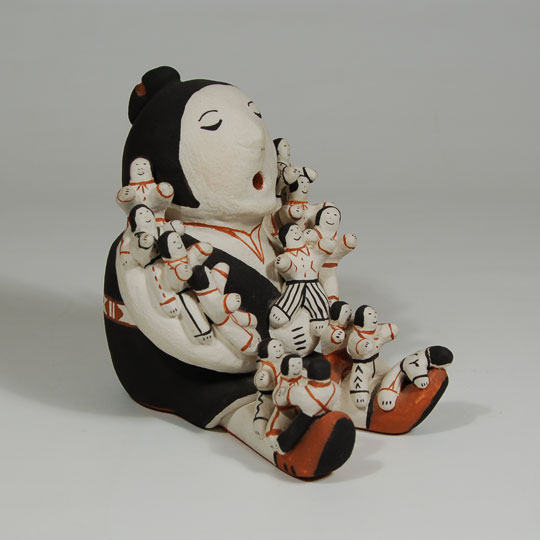 I have been unable to find any published information on Rufina Trujillo. In a personal conversation with Mary Trujillo of Cochiti Pueblo on 20 April 2010, I learned that she was originally from Acoma Pueblo and married a Cochiti Pueblo man and moved to Cochiti. She passed away in 2007 from complications of asthma. Mary said she does not think she made much pottery in her time at Cochiti.
I have been unable to find any published information on Rufina Trujillo. In a personal conversation with Mary Trujillo of Cochiti Pueblo on 20 April 2010, I learned that she was originally from Acoma Pueblo and married a Cochiti Pueblo man and moved to Cochiti. She passed away in 2007 from complications of asthma. Mary said she does not think she made much pottery in her time at Cochiti.
Glazed Columnar Wine Goblet, circa 1973 by Rick Dillingham - C3705A
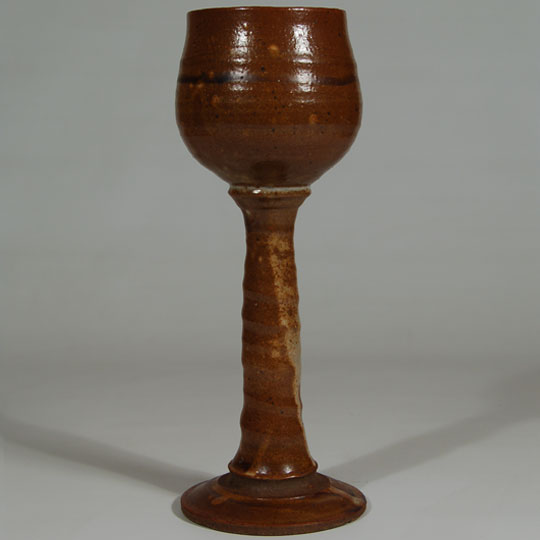 In an almost playful manner, Rick Dillingham created a single wine goblet of elegant yet casual appearance. The very standard round base gives way to a twisted tower that decreases in girth and spreads out to form the bowl.
In an almost playful manner, Rick Dillingham created a single wine goblet of elegant yet casual appearance. The very standard round base gives way to a twisted tower that decreases in girth and spreads out to form the bowl.
The goblet is signed but I do not see a date when it was made. One goblet we had in the past was dated 1973 so perhaps that is when he was making them. Since these were probably made in 1973, they might have been a college project.
Cochiti Figurine of a Seated and Chanting Drummer by Buffy Cordero Suina - C3688.54
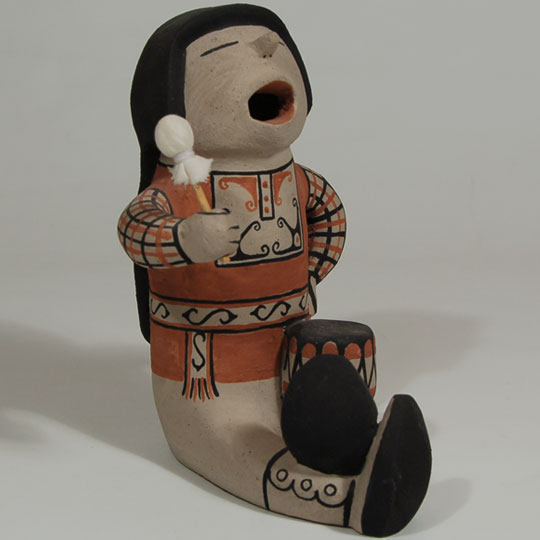 Helen Cordero's husband, Fred Cordero, was a drum maker. Cochiti and Taos Pueblos are famous for the drums made by men of the villages. It is known that Helen created the storyteller in honor of her grandfather. What is less known is that she created the drummer figurine in honor of her husband.
Helen Cordero's husband, Fred Cordero, was a drum maker. Cochiti and Taos Pueblos are famous for the drums made by men of the villages. It is known that Helen created the storyteller in honor of her grandfather. What is less known is that she created the drummer figurine in honor of her husband.
Cochiti Pueblo Standing Female Storyteller with 2 Kids by Maria Laweka - C3688.60
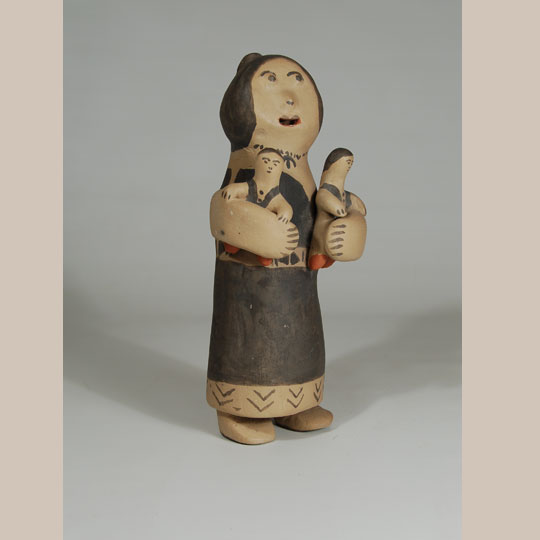 Maria Laweka was a daughter of Damacia Cordero, the famous figurine potter from Cochiti Pueblo, and sister to Martha Arquero and Josephine Arquero, both of whom were potters of note. It is not known if she is still making pottery figurines. Not many potters make standing figurines, perhaps because it is difficult to get them to balance and stand securely.
Maria Laweka was a daughter of Damacia Cordero, the famous figurine potter from Cochiti Pueblo, and sister to Martha Arquero and Josephine Arquero, both of whom were potters of note. It is not known if she is still making pottery figurines. Not many potters make standing figurines, perhaps because it is difficult to get them to balance and stand securely.
Hopi Pueblo Kuwan’Heheya Katsinas and Side Dancer by Emerson Quannie - 25875
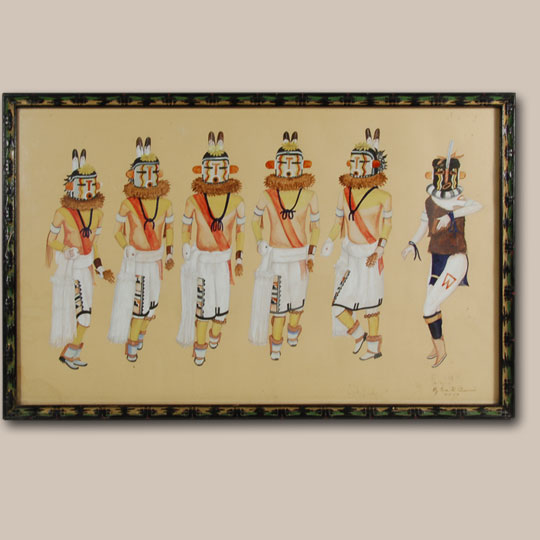 It is always tragic when a talented artist passes away at a young age, after demonstrating his or her talent to a limited audience. The questions always remain whether the artist would have continued in an art career and, if so, whether he or she would have continued producing such outstanding paintings.
It is always tragic when a talented artist passes away at a young age, after demonstrating his or her talent to a limited audience. The questions always remain whether the artist would have continued in an art career and, if so, whether he or she would have continued producing such outstanding paintings.
Emerson T. Quannie was born in the Hopi village of Kykotsmovi, on Third Mesa, in 1916. He attended the Albuquerque Indian School in 1932 and, while there, painted a mural at the Albuquerque Kimo Theater. According to his wife, Quannie did very little painting after leaving the Indian School. She knew of only one painting by him after their marriage in 1939. Seymour 1988.
Kewa (Santo Domingo) Pueblo Pictorial Storage Jar by Vidal Aguilar - C3513K
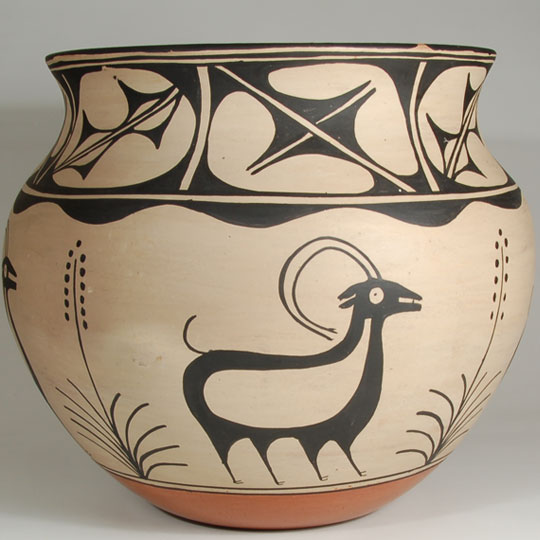 This large storage jar was purchased by the current owner directly from the potter about 15 years ago. It is decorated with pictorial elements of Mimbres rams and yucca plants. Pictorial elements on Kewa pottery, other than birds, are quite rare as almost all Kewa pottery is decorated with geometric designs in bold scale. For a potter at Kewa to use Mimbres animals on a jar is most unusual.
This large storage jar was purchased by the current owner directly from the potter about 15 years ago. It is decorated with pictorial elements of Mimbres rams and yucca plants. Pictorial elements on Kewa pottery, other than birds, are quite rare as almost all Kewa pottery is decorated with geometric designs in bold scale. For a potter at Kewa to use Mimbres animals on a jar is most unusual.
Original Hopi Pueblo Painting of Sotungtaka Katsina by T. T. Dashe - C3098B
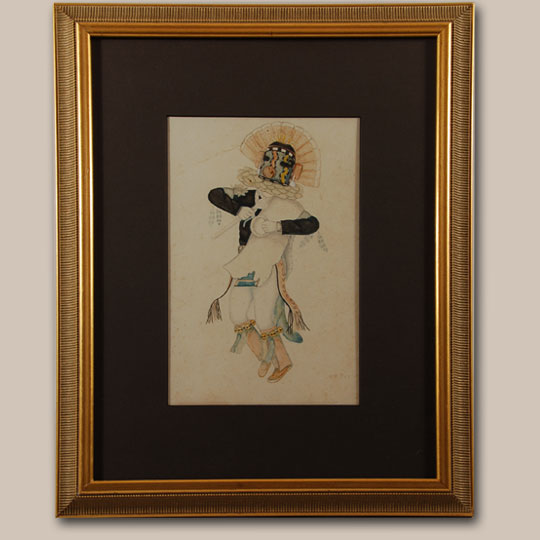 The katsina pictured here is one of the Corn katsinas. There is a typed label on verso that reads KAö KATCHINTA"A A M'. There is a Hopi Katsina named Qa'ö which also is a Corn Katsina, however, the image in this painting more closely resembles the Sotungtaka (Corn) Katsina than that of the Qa'ö (Corn) Katsina. Regardless, I think it is established that the image is that of a Corn Katsina.
The katsina pictured here is one of the Corn katsinas. There is a typed label on verso that reads KAö KATCHINTA"A A M'. There is a Hopi Katsina named Qa'ö which also is a Corn Katsina, however, the image in this painting more closely resembles the Sotungtaka (Corn) Katsina than that of the Qa'ö (Corn) Katsina. Regardless, I think it is established that the image is that of a Corn Katsina.
Sacred Corn is very important to the Hopi, as it means life. It is not unusual for there to be a number of Corn Katsinas in the Hopi pantheon.
Very Small Hopi Pueblo Laqan – Squirrel Katsina Doll - 25874
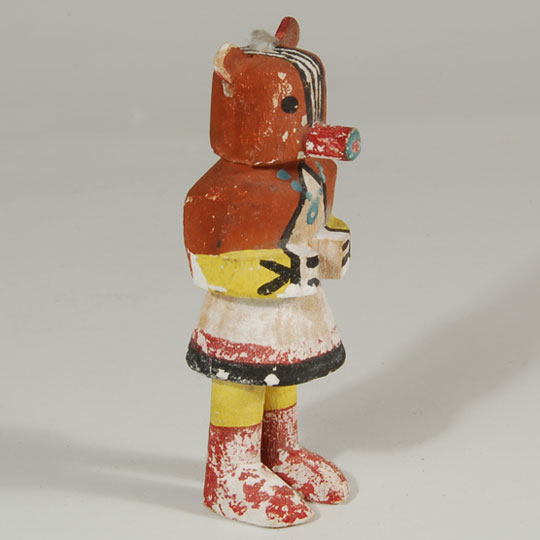 For two thousand years, the Hopi people have lived a desert lifestyle. They depend on water for their daily needs and for their plants, but water is in short supply. Over the years they have developed a system whereby they can pretty accurately forecast the weather, but that is not always sufficient for their needs. In order to ensure delivery of water when needed, they developed a pattern by which they ask for help from the supernatural forces that they believe control nature.
For two thousand years, the Hopi people have lived a desert lifestyle. They depend on water for their daily needs and for their plants, but water is in short supply. Over the years they have developed a system whereby they can pretty accurately forecast the weather, but that is not always sufficient for their needs. In order to ensure delivery of water when needed, they developed a pattern by which they ask for help from the supernatural forces that they believe control nature.
Historic Zuni Pueblo Olla with an Upside Down Deer - C3804A
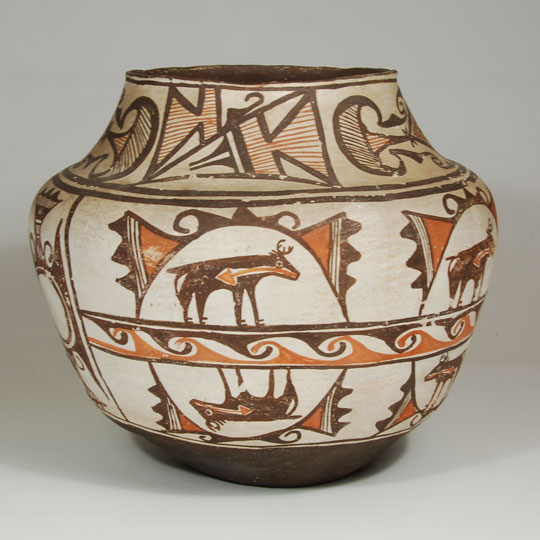 Assigning a date to Zuni Pueblo historic pottery is facilitated by the very large number of Zuni vessels collected for the Bureau of American Ethnology between 1879 and 1885, and by those collected for the American Museum of Natural History between 1899 and 1912.
Assigning a date to Zuni Pueblo historic pottery is facilitated by the very large number of Zuni vessels collected for the Bureau of American Ethnology between 1879 and 1885, and by those collected for the American Museum of Natural History between 1899 and 1912.
Sometime before 1870, potters began to paint their vessels' underbodies and the interiors of their necks black. In early cases, black was applied over the interior's red neck paint. In those vessels, the red is faintly visible through the black. Of course, a change of this nature did not occur overnight but may have occurred over several decades. It is believed that the change on the neck interior was completed by 1865. It was not until around 1900 that the underbody caught up with the neck.
Navajo Cast Silver and Turquoise Pin by Henry Morgan - 25781
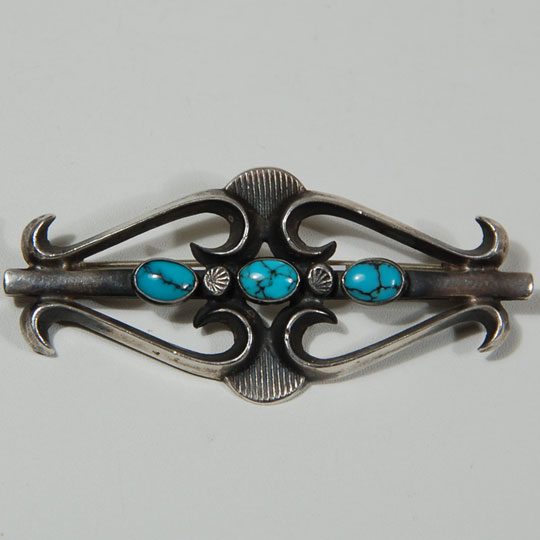 Henry Morgan is listed as a Navajo silversmith in jewelry books as having been producing since 1991, but there is no other biographical information. This wonderful pin was made in the cast method, then the three oval and domed turquoise cabs were attached in silver bezels.
Henry Morgan is listed as a Navajo silversmith in jewelry books as having been producing since 1991, but there is no other biographical information. This wonderful pin was made in the cast method, then the three oval and domed turquoise cabs were attached in silver bezels.
Navajo Cast Sterling Silver and Single Turquoise Bracelet by R Chee - 25780
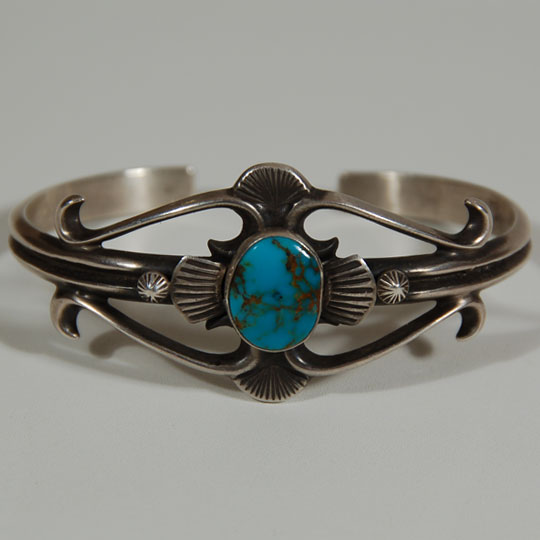 R. Chee is listed in jewelry books as a smith for State Line Indian Jewelry. He is from Window Rock, AZ. His jewelry is stamped R.CHEE. There is no first name given in the documentation.
R. Chee is listed in jewelry books as a smith for State Line Indian Jewelry. He is from Window Rock, AZ. His jewelry is stamped R.CHEE. There is no first name given in the documentation.
The bracelet was made in the cast form with the addition of the lined shell-shape elements attached on top near the turquoise and the two silver dots adjacent to the shells.
Black Bear with Fish in Paw and Cub on her Back by Dorothy Herrera - C3688.57
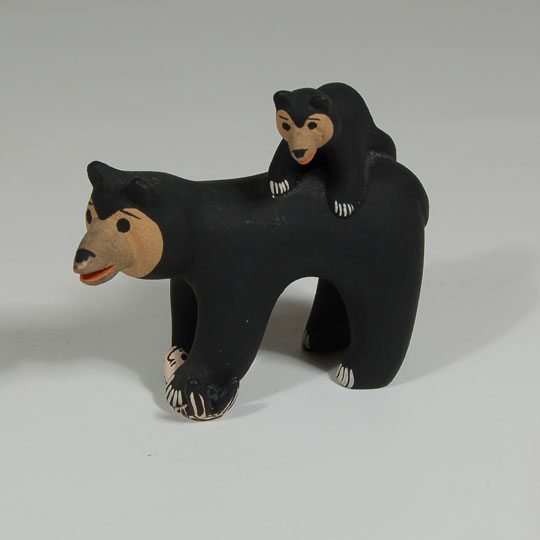 Dorothy Herrera formed a very realistic storyteller figurine of a mama bear with her cub. The multitasking female bear has also captured a fish in her left paw! Her single cub is riding on her back. He is watching her intently - learning how to be a successful hunter.
Dorothy Herrera formed a very realistic storyteller figurine of a mama bear with her cub. The multitasking female bear has also captured a fish in her left paw! Her single cub is riding on her back. He is watching her intently - learning how to be a successful hunter.
Cochiti Pueblo Seated Female Storyteller with 8 Children by Dorothy Herrera - C3688.56
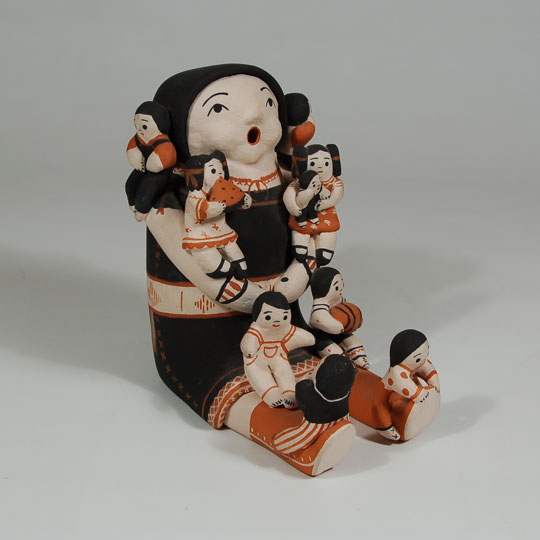 Cochiti Pueblo potter Dorothy Herrera is the granddaughter of Laurencita Herrera and daughter of Mary Frances Herrera. She has been making pottery, mostly storytellers, since the 1980s. This seated female storyteller figurine is dressed in the traditional pueblo dress that is over one shoulder and under the other one.
Cochiti Pueblo potter Dorothy Herrera is the granddaughter of Laurencita Herrera and daughter of Mary Frances Herrera. She has been making pottery, mostly storytellers, since the 1980s. This seated female storyteller figurine is dressed in the traditional pueblo dress that is over one shoulder and under the other one.
Yucatecas en el Parque - Yucatecan Women in the Park by Francisco Zuñiga - 25757
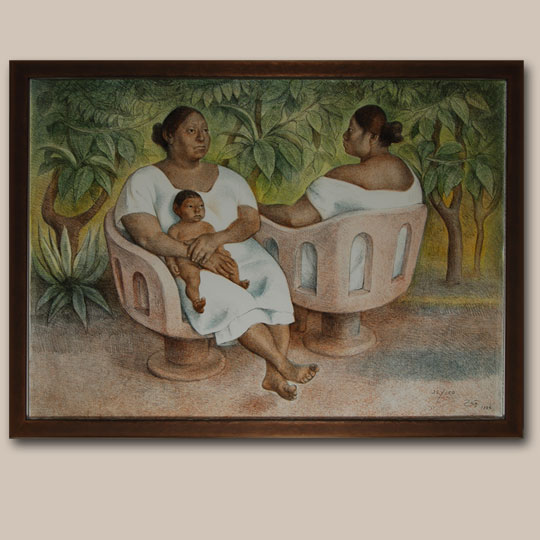 Yucatecas en el Parque is a stone lithograph executed in 6 colors. It was printed by Atelier Mourlot in Paris, France. The publisher was Brewster Editions, New York, New York. It was printed on handmade Arches Rives & Japan paper. There were 150 copies in the edition, and this is #32/150.
Yucatecas en el Parque is a stone lithograph executed in 6 colors. It was printed by Atelier Mourlot in Paris, France. The publisher was Brewster Editions, New York, New York. It was printed on handmade Arches Rives & Japan paper. There were 150 copies in the edition, and this is #32/150.
Francisco Zuñiga was born in Costa Rica at the end of the year 1912. As an early teenager, he assisted his father at his wood sculpture workshop where carving religious figures predominated. He began using oil paints at age 14, using his brother and sister as models. Two years later, he carved his first stone sculpture and it won Second Prize in the National Fine Arts Exhibition. He continued winning prizes in that competition for successive years.
Watercolor of Cochiti Pueblo Flute Dancer by Ow-u-Te-Wa - C3704B
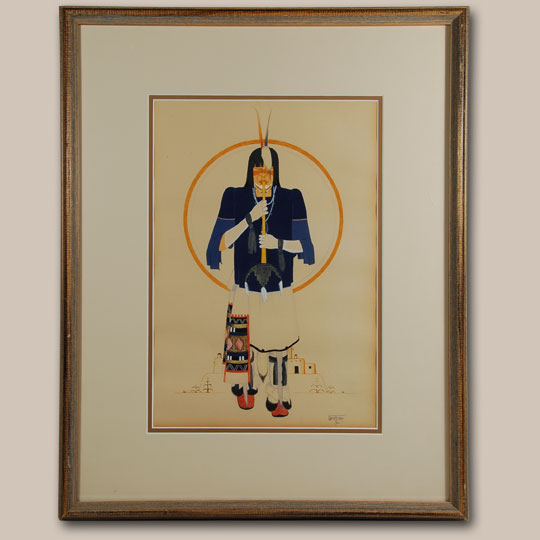 Manuel Bob Chavez (1915-2003) Ow-u-Te-Wa - Echo of a Song, who was born in 1915, painted in the traditional manner, then turned to a style all his own. This painting of a Cochiti "Flute Dancer" is of the traditional style and was painted when the artist was 25 years old. Generally, background materials were not included by Santa Fe Indian School students but Chavez included a pueblo building and corn plants in the field as background although they are a minor aspect of the painting.
Manuel Bob Chavez (1915-2003) Ow-u-Te-Wa - Echo of a Song, who was born in 1915, painted in the traditional manner, then turned to a style all his own. This painting of a Cochiti "Flute Dancer" is of the traditional style and was painted when the artist was 25 years old. Generally, background materials were not included by Santa Fe Indian School students but Chavez included a pueblo building and corn plants in the field as background although they are a minor aspect of the painting.
Original Painting of Two Galloping Horses by Tse Ye Mu - C3704A
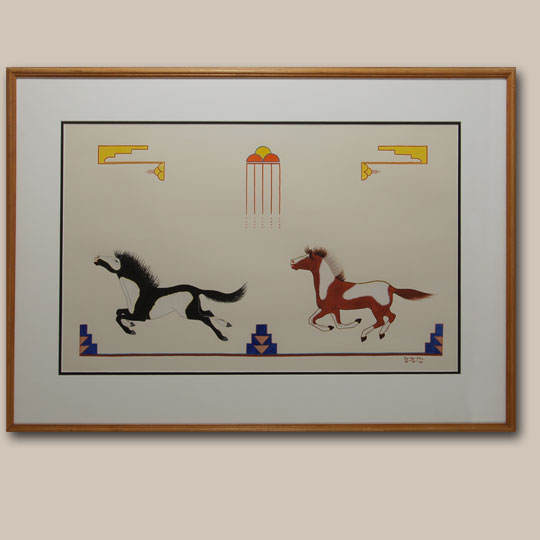 This excellent rendition of a pair of horses galloping toward some unknown destination documents well just how talented Romando Vigil (1902-1978) Tse Ye Mu - Falling Cloud was as an artist. He was painting in the early 1900s at San Ildefonso and is considered one of the early self-taught artist from there. He was a leader within the San Ildefonso Watercolor Movement, a movement that caught fire during 1915 to 1917. It fostered an art form unmatched in the cultural history of the world. These men portrayed tribal culture and local wildlife, attaining a flat decorative character, absent of backgrounds and foregrounds, and free of traditional perspective, with an unerring color sense.
This excellent rendition of a pair of horses galloping toward some unknown destination documents well just how talented Romando Vigil (1902-1978) Tse Ye Mu - Falling Cloud was as an artist. He was painting in the early 1900s at San Ildefonso and is considered one of the early self-taught artist from there. He was a leader within the San Ildefonso Watercolor Movement, a movement that caught fire during 1915 to 1917. It fostered an art form unmatched in the cultural history of the world. These men portrayed tribal culture and local wildlife, attaining a flat decorative character, absent of backgrounds and foregrounds, and free of traditional perspective, with an unerring color sense.
Seated Male Storyteller Figurine with One Child by Helen Cordero - 25779
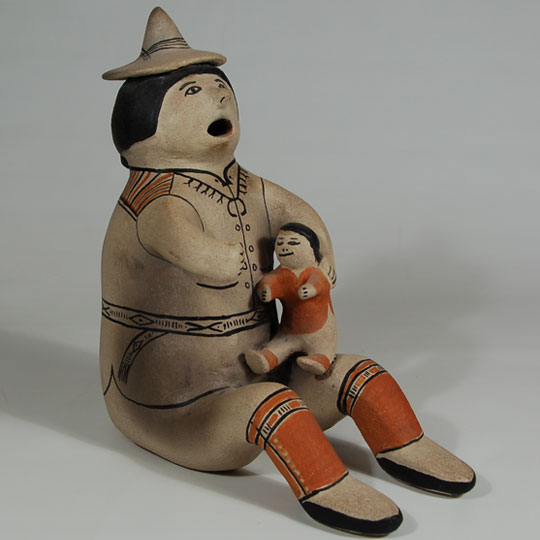 When Helen Cordero created what today is known as the Storyteller figurine, she reinvented a longstanding but inactive Cochiti Pueblo tradition of figurative pottery, a tradition dating back to the 1880s. She ignited a revolution in pueblo ceramic figurative pottery comparable to the revivals by Nampeyo of the Tewa village at Hopi and by Maria Martinez of the Tewa village of San Ildefonso.
When Helen Cordero created what today is known as the Storyteller figurine, she reinvented a longstanding but inactive Cochiti Pueblo tradition of figurative pottery, a tradition dating back to the 1880s. She ignited a revolution in pueblo ceramic figurative pottery comparable to the revivals by Nampeyo of the Tewa village at Hopi and by Maria Martinez of the Tewa village of San Ildefonso.
Helen Cordero started making pottery figurines in the late 1950s, mostly small frogs, birds, animals and small people. When she exhibited her pottery at a Santo Domingo feast day, folk art collector Alexander Girard bought all of the little people figures. He asked her to make more people figurines and bring them to him. He then asked her to make a larger seated figure with children. It was then that Helen began visioning her grandfather, Santiago Quintana, who was a good storyteller and grandchildren were always around him.
Diné - Navajo Ingot Silver and Turquoise Bracelet - 25486
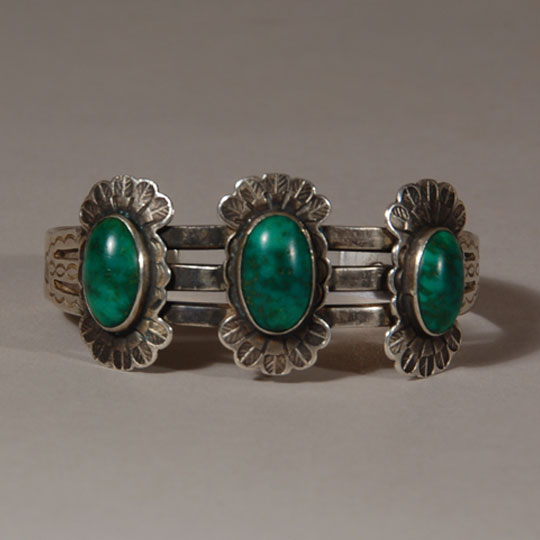 This bracelet was formed from ingot silver. It has a split shank, over which are three medallions of stamped silver featuring a beautiful green turquoise stone on each. The ends of the Southwest Indian Jewelry bracelet are profusely stamped. The bracelet dates to the 1930s.
This bracelet was formed from ingot silver. It has a split shank, over which are three medallions of stamped silver featuring a beautiful green turquoise stone on each. The ends of the Southwest Indian Jewelry bracelet are profusely stamped. The bracelet dates to the 1930s.
Sterling Silver and Obsidian Gaan Dancer Pendant by Jan Loco - C3558C
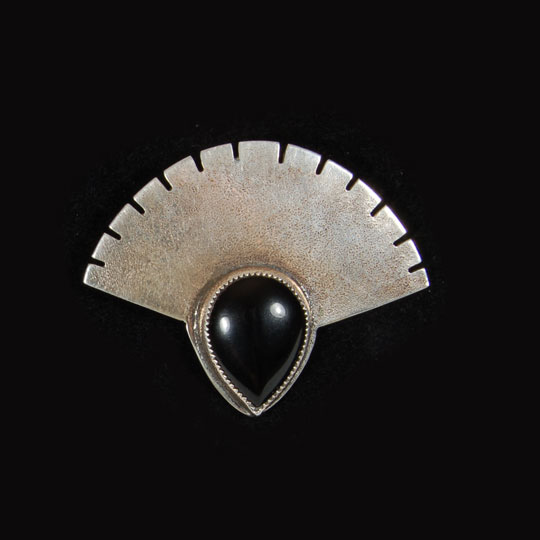 Jan Loco is a member of the Warm Springs Apache tribe. She began making jewelry in 1988. She has developed a method of making jewelry without the use of hand tools. After cutting the silver to the desired shape (with heavy-duty poultry scissors or something similar), she hammers it with a specially selected rock until she achieves the texture she desires. This is a laborious task, but she feels it honors her ancestry to use items of nature rather than power tools.
Jan Loco is a member of the Warm Springs Apache tribe. She began making jewelry in 1988. She has developed a method of making jewelry without the use of hand tools. After cutting the silver to the desired shape (with heavy-duty poultry scissors or something similar), she hammers it with a specially selected rock until she achieves the texture she desires. This is a laborious task, but she feels it honors her ancestry to use items of nature rather than power tools.
Historic Zia Pueblo Small Dough Bowl or Serving Bowl - C3215L
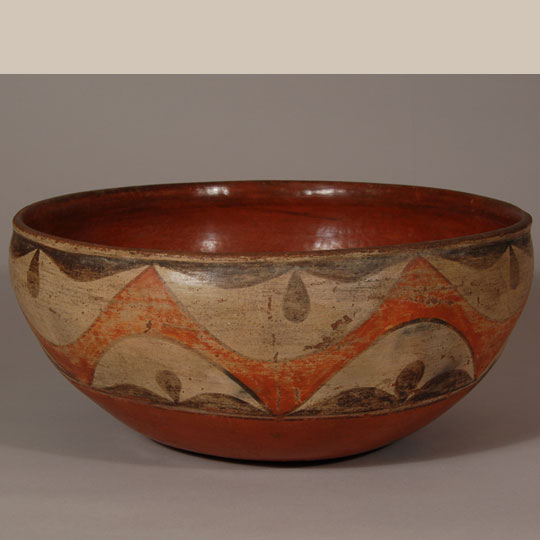 There were probably more bowls made in New Mexico Pueblos than there were jars. Very large bowls, called dough bowls, were used for preparing bread dough; medium-size ones were used for preparation of tortilla dough, serving food at the table or for storage and even overturned as a lid for covering jars; the smallest bowls were used for daily meals.
There were probably more bowls made in New Mexico Pueblos than there were jars. Very large bowls, called dough bowls, were used for preparing bread dough; medium-size ones were used for preparation of tortilla dough, serving food at the table or for storage and even overturned as a lid for covering jars; the smallest bowls were used for daily meals.
This historic bowl is a medium-size one, and that shows no wear from use. It was probably purchased when made and was probably made in the 1930s or so. The rim of the bowl rises up from a slight indention just below. The design is a sinusoidal wave encircling the vessel.

